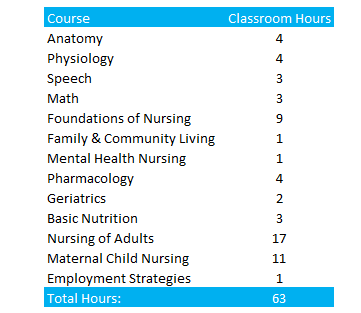While there may be small differences in the curriculum, hours and teaching styles of different LPN training programs, most accredited courses have the same basic structure.
Training combines basic sciences and medical theory with hands-on practice in nursing fundamentals, and prepares students to work in most practical nursing positions.
The following section answers some of the most-frequently asked questions that future practical nursing students have about LPN programs.
What are the Prerequisites for LPN Training?
In most cases, applicants to practical nursing training programs are required to have either a high school diploma or GED. It is also becoming increasingly common for schools to require applicants to show proof of having completed certain courses in high school (usually biology and physiology).
This checklist reflects additional admission requirements one may find for accredited programs:
Some states may place additional requirements on their nurse training programs as well, so it’s best to speak to someone from the school directly and ask them about their specific prerequisites.
What is Covered in Class?
Accredited LPN training courses are divided into two distinct sections: in-class study, and clinical training. The in-class portion of the program will usually focus on a broad spectrum of health and science topics, as well as some general education material (e.g. math).
The following sample curriculum from North Central Missouri College’s LPN program is typical of what one should expect to find in most accredited courses:

Source: www.ncmissouri.edu
What is Clinical Training?
In addition to theory-based study in the classroom, practical nursing students are also required to complete a set number of supervised clinical training hours. While the exact number of hours may vary from one state to the next, this portion of the program is usually completed through either an externship at a local hospital or other healthcare facility, or through a simulated lab setting at the school itself.
Activities that students usually participate in during clinical training include:
- Observing on-duty nursing personnel during their shifts
- Taking patients’ vital signs
- Assisting patients with eating, bathing and dressing
- Administrative support (e.g. filling-out medical reports)
Some programs also provide opportunities for their LPN candidates to acquire specialized training during clinicals. This is most-often seen in the field of geriatrics, where students who are training at assisted living facilities receive highly-focused instruction that will prepare them to work in home care or another sector of the industry that specializes in caring for the elderly.
How Long is LPN Training?
Most LPN training programs are roughly the equivalent of associate’s degree programs – meaning that you should expect to spend two years completing your studies. However, there are a number of online LPN programs and other types of accelerated courses that can reduce the time required to as little as six months.
What to Expect During LPN Training
While there may be small differences in the curriculum, hours and teaching styles of different LPN training programs, most accredited courses have the same basic structure.
Training combines basic sciences and medical theory with hands-on practice in nursing fundamentals, and prepares students to work in most practical nursing positions.
The following section answers some of the most-frequently asked questions that future practical nursing students have about LPN programs.
What are the Prerequisites for LPN Training?
In most cases, applicants to practical nursing training programs are required to have either a high school diploma or GED. It is also becoming increasingly common for schools to require applicants to show proof of having completed certain courses in high school (usually biology and physiology).
This checklist reflects additional admission requirements one may find for accredited programs:
Some states may place additional requirements on their nurse training programs as well, so it’s best to speak to someone from the school directly and ask them about their specific prerequisites.
What is Covered in Class?
Accredited LPN training courses are divided into two distinct sections: in-class study, and clinical training. The in-class portion of the program will usually focus on a broad spectrum of health and science topics, as well as some general education material (e.g. math).
The following sample curriculum from North Central Missouri College’s LPN program is typical of what one should expect to find in most accredited courses:
Source: www.ncmissouri.edu
What is Clinical Training?
In addition to theory-based study in the classroom, practical nursing students are also required to complete a set number of supervised clinical training hours. While the exact number of hours may vary from one state to the next, this portion of the program is usually completed through either an externship at a local hospital or other healthcare facility, or through a simulated lab setting at the school itself.
Activities that students usually participate in during clinical training include:
Some programs also provide opportunities for their LPN candidates to acquire specialized training during clinicals. This is most-often seen in the field of geriatrics, where students who are training at assisted living facilities receive highly-focused instruction that will prepare them to work in home care or another sector of the industry that specializes in caring for the elderly.
How Long is LPN Training?
Most LPN training programs are roughly the equivalent of associate’s degree programs – meaning that you should expect to spend two years completing your studies. However, there are a number of online LPN programs and other types of accelerated courses that can reduce the time required to as little as six months.